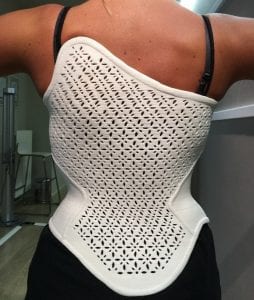 Nothing is more important than health, and today digital technologies are becoming indispensable in this field.
Nothing is more important than health, and today digital technologies are becoming indispensable in this field.
The technology of 3-D scanning and modeling allows you to create corsets purely individually. These corsets strictly correspond to the anatomy of each individual patient.
A 3D scanner is an important attribute of medical research centers and practicing medical institutions around the world.
The manufacture of Cheneau corset begins with the creation of a 3D model of the patient’s body. Digital technologies have changed the very concept of production of corsets, making it cheaper, more functional, reliable and more convenient.
Scanning (the so-called process of obtaining the exact 3D model of the structure of the human body or its individual parts) will pass through the measuring equipment of the 4th generation.
The result of scanning is a computer 3D model (scan), ideally reflecting the individual features of the figure of each patient with an accuracy of 20 microns.
Computer modeling in the manufacture of corsets (using CAD-CAM technology) avoids gross violations in the structure and shape of the corset that occur in every second “gypsum” corset and is subsequently accompanied by bruises, hematomas and rib deformations on the patient’s body.
The use of modern mobile scanning devices allows the patient to be scanned even when lying in a hospital or at home in a patient. This is very important in the case when the patient is limited in mobility due to his condition.
The use of digital technologies in orthopedic technology greatly facilitates the orthopedic support of patients with muscular torticollis. The patient can be scanned in any position. Head position correction is then performed in a computer program.
The principle of scanning is very simple. 3D scanning is a non-contact process of transferring a real object to a digital format. The camera reads the light reflections and gets distorted the image of the scanned object. With structured lighting, the object is illuminated by a certain “pattern” (grid), by distortions of which the camera forms the 3d model.
The result of the process is a three-dimensional model of the object in the form of a file, which describes information about object polygons in one of the formats STL, OBJ, 3ds, so that they can be further edited and used in 3D StudioMAX, Maya, Alias, Inventor, SolidWorks and other 3D modeling packages. This data is either stored in the scanner’s memory, and then transferred to the computer, or immediately sent to the computer, where they are processed and build a three-dimensional model.
The estimated time of human scanning is 20-25 minutes. Using a 3D scanner to scan a person, getting his volumetric digital model is completely safe for health. The usual digitization does not use any harmful radiation, nor does it have any negative effects.
Advantages of the active 3d scan method:
- The low cost of scanning and the simplicity of the process,
- a compact amount of received files,
- possibility of using outdoors,
- use in different lighting,
- High-precision scanning of ribbed surfaces and prismatic parts,
- Scanning is done by contactless technology,
- It is possible to scan objects not available for other scanning methods.
Disadvantages of laser 3D scanners:
- the complexity of scanning mobile objects (therefore, when scanning the patient, they are asked not to make unnecessary movements),
- impossibility to scan shiny and mirror surfaces.
Image credit: WASP
